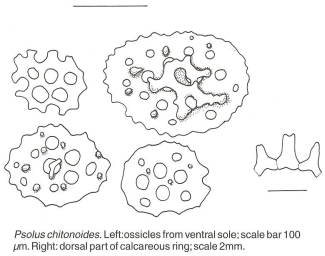chitonoides = like a chiton
|
Psolus chitonoides is a suspension feeder. The tentacles trap larger particles (greater than 2 mm) by bending inwards to form a cagelike enclosure. The mouth lips extend toward the particle as the nearest tentacle pushes it into the mouth.
Spawning occurs from mid March to late May, commonly in the early morning. A spawning male will swab its genital papilla with its tentacles, then lift the tentacles to disperse the sperm. Females release long ropes of brick red eggs (mean diameter 627 μm). Fertilized eggs develop into pelagic lecithotrophic vitellaria larvae. Late larvae and early juveniles are negatively phototactic and settle gregariously.
Toxic chemicals (saponins) discourage fish from nipping the tentacles. Even the Kelp Greenling (Hexagrammos decagrammus) - which commonly feeds on sea cucumbers - avoids P. chitonoides. The Sun Star (Solaster stimpsoni), the Leather Star (Pycnopodia helianthoides) and the Red Rock Crab (Cancer productus) prey on P. chitonoides.
|
|
